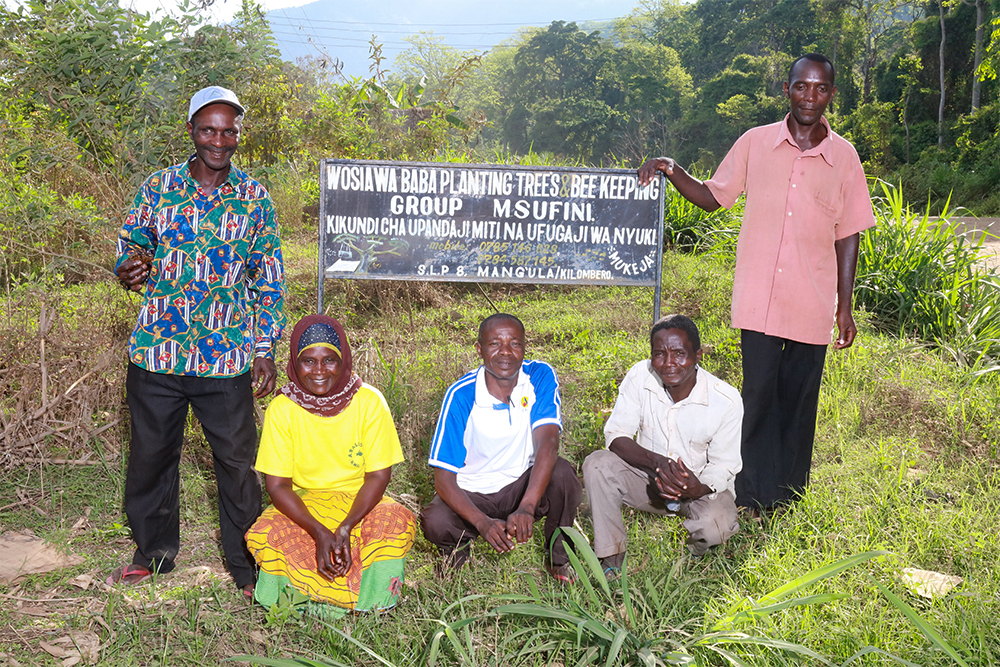Buzz-boosting techniques – The case of beekeeping in the Eastern Arc Mountains of Tanzania

Summary
This solution, consisting of the implementation of beekeeping activities in different communities adjacent to the Udzungwa Mountains National Park in Tanzania, represents an alternative source of livelihood and a successful strategy that has helped reduce unsustainable activities such as logging in the targeted areas. It contributes to reducing human pressure on local ecosystems already affected by climate change.
Udzungwa Mountains National Park in the Eastern Arc Mountains, south-central Tanzania, is a habitat for many endemic species of fauna and flora. The park’s mountains serve as a water tower for communities in the region and many agricultural livelihoods rely on this water source. However, people also put pressure on the park’s natural resources through poaching, unsustainable timber harvesting and cutting down trees for cooking fuel. The increased temperatures, decrease in precipitation and increased incidence of crop pests and diseases affects agricultural productivity, making the communities turn to forest resources to supplement and sustain their livelihoods.
In 2001, as a joint initiative of the Government of Tanzania, the World Bank and the Global Environment Facility, the EAMCEF was established as a permanent and long-term funding mechanism to provide sufficient and reliable funds for the effective conservation of the Eastern Arc Mountains. It identified beekeeping as one of the main alternative livelihoods for rural communities living adjacent to the protected areas of the national park. Therefore, in 2012 the fund initiated a series of beekeeping projects in Korogwe, Mkinga, Lushoto, Same, Morogoro, Kilombero, Mvomero, Kilolo and Mufindi districts that have been highly effective, with community members now using part of their land near the park to plant trees as a way to conserve the environment, as well as to house the hives.
Overview
- Location:
- Implementation sites:
- Single country
- Single location
- Mountain region:
- Udzungwa Mountains
- Province:
- Korogwe, Mkinga, Lushoto, Same, Morogoro, Kilombero, Mvomero, Kilolo and Mufindi districts
- Solution scale:
- Ecosystem type(s):
- Solution type(s):
- Sector(s):
- Climate impact(s) addressed:
- Impact time-scales:
- Co-benefits:
- Implementation timeline:
- 2012 - 2022
Solution details
Main beneficiaries & outcomes
Beekeeping activities in the target region have benefited a total of 1,570 villagers, who have been trained in modern beekeeping techniques. More than 82 groups of beekeepers have been formed and are in charge of the 1,352 modern hives that were supplied to the village groups. Women are among the beneficiaries and are an active part of the groups.
The beekeeping groups generate two types of products: honey and beeswax. Since the start of the project in 2012, it is estimated that more than 14,180 liters of honey have been harvested per year and 508 kilograms of beeswax have been collected, generating sales revenue of 7,6647,400 Tanzanian shillings, which is equivalent to about $33,000. This has reduced pressure on the forest in the protected areas, as they no longer see the need to trespass in the protected forest to make a living.

Planning and implementation
The implementation of the solution is supported by the Eastern Arc Mountain Conservation Endowment Fund (EAMCEF), which now operates as a Not-for-Profit Non-Governmental Organization and helps provide the necessary training to the formed groups.
An important aspect that led to the implementation of this solution was the existence of the Wosia wa Baba, a group of beekeepers formed 10 years before the EAMCEF intervention by a group of 6 local farmers. This group, despite their keen interest in the production of bee products, lacked the necessary training and equipment to carry out their activities, and unintentionally started fires in the forest, which led to a ban on such activities by the forestry authority, who put in place strong measures to prevent people from trespassing the forests. EAMCEF then used the group, which continued beekeeping but on a smaller scale in areas close to their homes, to teach modern beekeeping techniques and create new groups.
Finance
With financial support from the EAMCEF, modern beekeeping interventions started as early as 2012 to provide an alternative source of livelihood and incentivize the communities to stop encroaching on the protected areas. The initiative started with 15 million Tanzanian Shillings ($9,375) to support the beekeepers and tree planting. Members of the communities are still supported with modern beekeeping techniques.
Innovation
The implementation of this type of activity in the area can be considered innovative, as the solution introduced modern beekeeping techniques along with nature conservation. Local groups no longer need to set fires in areas close to the forest to scare away the bees while collecting honey, which posed great risks to these protected areas already suffering from wildfires as the most challenging issue.
Outlook & Scalability
Transformation and future outlook
One of the main highlights of the implementation of this solution in the Udzungwa Mountains area is that it is accompanied by raising awareness among the local communities about the possibility of carrying out economic activities in a climate-appropriate and environmentally friendly way, as well as the importance of protecting the fragile forests in order for biodiversity to thrive in the region. Prior to EAMCEF’s intervention, beekeeping groups tried to continue practicing beekeeping by planting trees in the village but soon realized that this was not as productive as doing it in the rich forests.
Potential for upscaling and replication
The scaling up and replication of this solution by EAMCEF is very likely due to the fact that beekeeping proved to be one of its most successful interventions in the region. In fact, beekeeping is supported and promoted by the fund under the thematic area of Community Based Conservation and Development (CD).





(0) Comments
There is no content